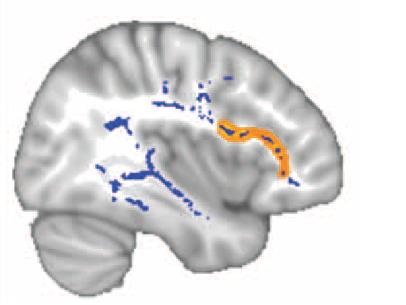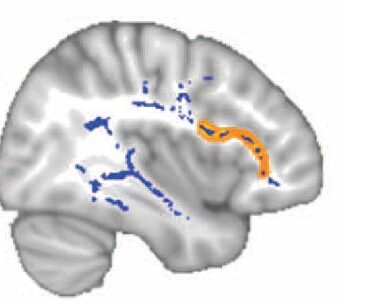Researchers have observed brain abnormalities among people who are dependent on stimulant drugs (Ersche et al., 2011). More specifically, these individuals show abnormalities in fronto-striatal brain systems known to be involved in self-control (Ersche et al., 2011). It is also known that self-control deficits increase the risk for substance use disorders (Nigg et al., 2006), and that brain structure is largely inherited (Wright et al., 2002). Consequently, inherited patterns of brain structure and function that increase an individual’s risk for impaired self-control likely increase the risks of stimulant dependence. Ersche and colleagues (2012) recently explored this hypothesis by studying the brain structure and functioning of drug-dependent individuals and their non-dependent siblings.
Methods
- Researchers recruited 50 biological sibling pairs. In each pair, one sibling met DSM-IV criteria for current dependence on cocaine or amphetamine, and the other sibling had no history of substance dependence (except nicotine).
- The researchers also recruited 50 unrelated, non-drug dependent volunteers matched with the siblings on age and intelligence quotient.
- All participants performed a button-press behavior repeatedly and quickly except whenever they heard an auditory signal. This task that measured inhibitory control, an aspect of self-control. The researchers measured how long it took participants to refrain from pressing the button during these “stop” trials. The resulting measure, the stop-signal reaction time (i.e., SSRT), predicts the onset of substance abuse among vulnerable individuals (Nigg et al., 2006).
- All participants underwent magnetic resonance brain scans, which allowed the researchers to quantify and compare the integrity of white matter fiber tracts and the volume of gray matter throughout the brain.
Results
- Both drug-dependent individuals (t (95) = 3.83, p < .001) and their non-dependent siblings (t (97) = 3.73, p < .001) had longer SSRTs than the control group participants, suggesting impairments in the regulation of behavior.
- Looking specifically at neural networks used during inhibitory control (i.e., the basal ganglia, inferior frontal gyrus, and presupplementary motor area), the biological siblings showed less white matter integrity than the control group (group F (2, 141) = 26.2, p < .001). See Figure 1.
- Reduced white matter integrity in this neural network was associated with worse inhibitory performance (i.e., longer SSRTs) (r = 0.24), suggesting that white matter integrity within this neural network is an objective marker of poor inhibitory control, a risk factor for stimulant drug dependence.
- Certain sections of gray matter were significantly smaller among the biological siblings as compared to the controls, including areas known to be involved in addiction (e.g., medial temporal lobe, basal ganglia, orbitofrontal cortex, putamen).

Figure. A depiction of white matter integrity. The blue shading represents areas in which the participant groups differed in terms of white matter integrity. The orange shading represents the inferior frontal gyrus and presupplementary motor area. From Ersche et al. (2012).
Limitations
- Although some drug-dependent participants were recruited from treatment centers, the authors do not provide information regarding the potential association between treatment history and brain function or structure.
- Because the authors focused on the effects of stimulant dependence, it is unclear if people who are dependent on other substances or experience behavioral expressions of addiction (e.g., gambling) exhibit similar patterns.
- The non-dependent siblings showed deficits in neural networks known to be involved in self-control, as well as impaired self-control. However, this study is not positioned to explain why these individuals did not go on to develop drug dependence.
Conclusion
A thorough family history is crucial in studying inherited brain structure and determining illness for which individuals are at risk. This study’s findings suggest two conclusions. First, the results lend support to the idea that some risk for substance dependence is inherited with brain structure and functioning and suggests that there might be some merit in either monitoring or providing more specialized treatment to those with a family history of substance use. At the same time, the comparison of biologically related siblings implies that some people, whether through personality differences, lack of drug exposure, brain chemistry, or some other set of protective factors, are able to work against an apparent predisposition to substance dependence. Future work should explore, among other issues, these individuals’ marked ability to resist addiction.
-Ingrid Maurice & Heather Gray
What do you think? Please use the comment link below to provide feedback on this article.
References
Ersche, K. D., Barnes, A., Jones, P. S., Morein-Zamir, S., Robbins, T. W. & Bullmore, E. T. (2011) Abnormal structure of frontostriatal brain systems is associated with aspects of impulsivity and compulsivity in cocaine dependence. Brain, 134, 2013-24.
Ersche, K. D., Jones, P. S., Williams, G. B., Turton, A. J., Robbins, T. W. & Bullmore, E. T. (2012) Abnormal brain structure implicated in stimulant drug addiction. Science, 335, 601-4.
Nigg, J. T., Wong, M. M., Martel, M. M., Jester, J. M., Puttler, L. I., Glass, J. M., Adams, K. M., Fitzgerald, H. E. & Zucker, R. A. (2006) Poor response inhibition as a predictor of problem drinking and illicit drug use in adolescents at risk for alcoholism and other substance use disorders. Journal of the American Academy of Child & Adolescent Psychiatry, 45, 468-475.
Wright, I. C., Sham, P., Murray, R. M., Weinberger, D. R. & Bullmore, E. T. (2002) Genetic contributions to regional variability in human brain structure: methods and preliminary results. Neuroimage, 17, 256-71.




